Lithofacies and sedimentary characteristics of the Silurian Longmaxi Shale in the southeastern Sichuan Basin, China
Jiang Zaixing , Guo Ling, Liang Chao
1. College of Energy, China University of Geosciences (Beijing), Beijing 100083, China
2. Department of Geology, Northwest University, Xi’an 710069, China
Abstract The Silurian Longmaxi Shale (SLS) is the target for shale gas exploration and exploitation in the southeastern Sichuan Basin. Based on detailed description of cores and outcrops, analysis of Gamma Ray (GR) logs, thin sections and mineralogical data, the SLS can be subdivided into six lithofacies: (1) clayey shale, (2) siliceous calcareous shale, (3) siliceous dolomitic shale, (4) silty-clayey interlaminated shale, (5) muddy siltstone, and (6) graptolite shale. Three facies associations are recognized in the study area, i.e., inner shelf, outer shelf, and bathyal plain (including turbidite) facies. Outer shelf and bathyal plain facies dominate the lower interval of the SLS, while inner shelf facies dominates the upper part of the SLS.The thickness of the black shale in the northern part of the study area is the greatest, where siliceous calcareous shale, siliceous dolomitic shale, and graptolite shale are predominant.These three kinds of shale are rich in total organic carbon (TOC) content and brittle minerals,which is favourable for the accumulation of shale gas and its future exploitation.
Key words Longmaxi Shale, Silurian, lithofacies, sedimentary characteristics, Sichuan Basin
1 lntroduction*
Shale gas exploration and exploitation has become feverish worldwide with new discoveries announced frequently in the United States (Abouelresh and Slatt, 2012).Commercial exploration and development of shale gas is presently mostly limited to North America, especially the USA (Hill and Nelson, 2000; Curtis, 2002; Jarvieet al.,2007). Large-scale development and utilization of shale gas have brought a revolution in the energy supply (Bowker, 2007; Jarvieet al., 2007). Shale gas has now attracted the attention of many countries, especially those major energy consumers, such as the USA, Germany and China.Recently, the Chinese government has put great emphasis on shale gas exploration and started a number of shale exploration projects. The southeastern Sichuan Basin is one of the first strategic pilot test areas for shale gas exploration. The Silurian Longmaxi Shale (SLS) is one of the few mature gas shales in China, and it was initially tested with vertical wells. The results show that there is a large amount of shale gas reserves within the SLS (Zhanget al., 2010).
The stratigraphy of the SLS and the structure of the Sichuan Basin have been studied by many researchers, including Zhao (1984), Tong (2000), Suet al. (2007), and Liuet al. (2010). More recently, there have been more contributions on shale gas geology by Puet al. (2010) and Zhanget al. (2011), on reservoir characterization (Chenet al., 2011), and on sedimentary characteristics (Guoet al.,2011, Zhanget al., 2012). But the lithofacies of the SLS have not yet been studied. The SLS, as shale gas play, was evaluated by Puet al. (2010), Zhanget al. (2010), Liuetal. (2011), and Chenet al. (2012). The terms “Longmaxi Formation” and “Longmaxi Shale” have been used formally. The term “Longmaxi Shale” is misleading because most of the Longmaxi Formation is mudstone rather than shale (Zhanget al., 2012), but we still prefer this name here because of its wider usage. In the general discussion of the play type, however, we use the term “shale” to include shale, mudstone, silty mudstone and some thin-bedded siltstone.
This article presents results of the investigation of lithofacies, sedimentary facies, and shale gas potential based on the analyses of a continuous 324.6 m vertical core(Well Yuye 1, the first strategy survey well for shale gas in China) in Pengshui County, and some field outcrops in the Sichuan Basin. The objectives of this article are (1)description and classification of SLS lithofacies, (2) determination of the characteristics of sedimentary facies associations, and (3) evaluation of lithofacies and sedimentary facies as an effective shale gas play in the study area.
2 Geologic setting
The study area is located in the southeastern part of the Sichuan Basin (Fig. 1A),i.e., at the intersection of Dalou Mountain and Wuling Mountain (Su, 2001; Wuet al.,2011). The Sichuan Basin, formerly the Sichuan Plateau on the eastern coast of the Palaeo-Tethys, was formed during the Late Triassic Indosinian orogeny. It is situated in the eastern part of the former Sichuan Province, which was divided into the Sichuan Province and the Municipality of Chongqing in 1997. The Sichuan Basin is bounded by faults on all sides (Fig. 1A), and is characterized by thick (up to 9 km) Mesozoic continental deposits (Guoet al., 1996). The surrounding structural belts developed at different times and in quite contrasting ways, thereby exerting diverse influences upon the Sichuan Basin evolution (Menget al., 2005). Administrative regions include the southeastern part of Chongqing city, the southwestern part of Hubei Province, and the northwestern part of Hunan Province (Fig. 1B). The geologic setting of the SLS in the Sichuan Basin was characterized, particularly, by Fuet al. (2008) and Xuet al. (2011). Palaeozoic strata comprise almost the entire sedimentary filling of the basin (Fuet al.,2008; Xuet al., 2011). The SLS was deposited in the Early Silurian Longmaxi stage. Deposition occurred in a foreland basin that had generally a restricted circulation with the open ocean; detrital materials came chiefly from the Chuandian Uplift which was located in the southeastern part of the study area (Yinet al., 1999; Chenet al., 2004;
Wanget al., 2010). The SLS is 250 m in thickness in the northern part of the study area and 15 m in its southern part. The SLS overlies the Ordovician Wufeng Shale (Suet al., 2007) and is covered by Mid-Silurian gray shale and light gray to yellow siltstone (Fig. 2).
3 Materials and methods
This study employs an approach that integrates sedimentology, mineralogy, and elemental geochemistry. It is based on investigations of core logs and outcrops, as well as petrographic studies. The basic data include nearly 330 m of core from the Well Yuye 1, 3 km long outcrops, index of evaluating hydrocarbon source rock, reservoir data from cores and outcrops, mineralogical data from 95 samples,and elemental data from 105 samples. The palaeontological data are from the Nanjing Institute of Geology and Palaeontology. The mineral and element data are provided by the North China Petroleum Exploration and Development Research Institute.
Sedimentary facies in the study area are identified mainly from colour, sedimentary structures, fossils, and mineral and elemental data from cores and outcrops. Lithofacies and mineral identification are based on thin sections.
4 Results
4.1 Lithofacies and sedimentary facies
Detailed description of slabbed core and outcrops, comparison with spectral core gamma logs, analysis of 54 thin sections, and analysis of mineral data from 95 samples have allowed us to subdivide the SLS into the following six lithofacies: (1) clayey shale, (2) siliceous calcareous shale, (3) siliceous dolomitic shale, (4) silty-clayey interlaminated shale, (5) muddy siltstone, and (6) graptolite shale. Average total organic carbon (TOC) content and mineral composition of the SLS are listed in Table 1.
4.1.1Clayey shale
This lithofacies is common in Well Yuye 1, especially in its upper interval (0-100 m). It is characterized by high contents of clay minerals, with an average content of 51 wt.%; quartz is the next most common mineral, with an average content of 34 wt.%. Average content of pyrite is 1.6 wt.%. Gray colour is very common in this kind of shale(Fig. 3A), and thin sections under microscope often reveal a complex range of colours including dark yellow and gray (Fig. 3B). Massive and faint horizontal bedding are the dominantly sedimentary structures in the clayey shale.Carbonate minerals are absent. U content is relatively low compared with the lower interval (deeper below than 100 m, see Fig. 5) composed of siliceous dolomitic shale and graptolite shale. Both K and Th are abundant (see Fig. 5).Average total organic carbon (TOC) content is 1.1 wt.%(Table 1).
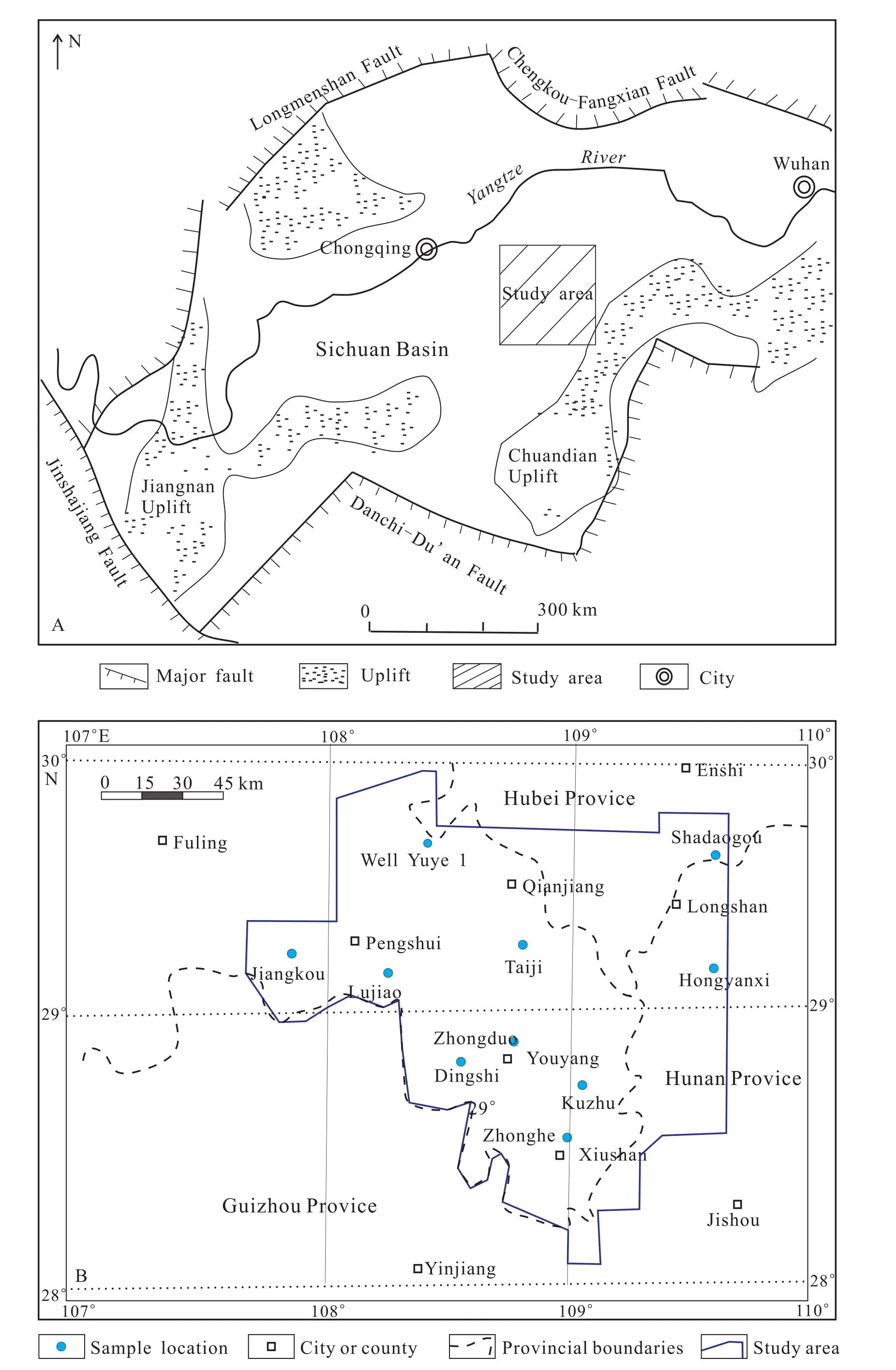
Fig. 1 Sketch map of the study area in Sichuan Basin (A) and sample locations (B).
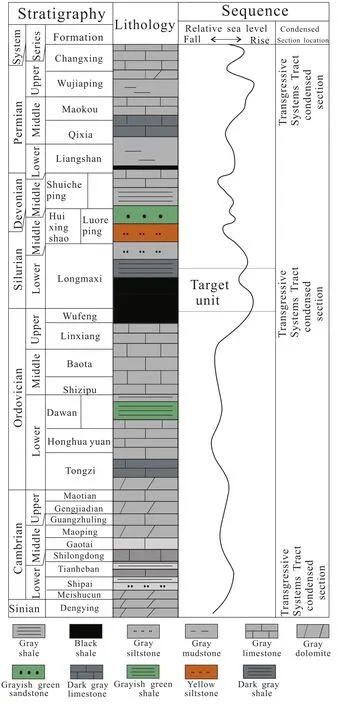
Fig. 2 Comprehensive stratigraphic column of the study area.
4.1.2Siliceous calcareous shale
Siliceous calcareous shale is characterized by horizontal bedding (Fig. 3D). Average content of carbonates is more than 6 wt.% in core and 20 wt.% in outcrop samples, while dolomite content is often less than 3 wt.%.This lithofacies is found throughout the SLS interval, but its thickness is usually less than 2 m. It consists mainly of dark to light gray interlaminations with sharp to gradational contacts (Fig. 3C, 3D). The light gray lamina are rich in calcite (about 30 wt.% in average). Average content of pyrite and TOC is 3.4 wt.% in the outcrop samples and 2.1 wt.% in the core.
4.1.3Siliceous dolomitic shale
Siliceous dolomitic shale is most common in the lowermost part of the SLS. It is characterized by its black colour, massive horizontal bedding (Fig. 3G), and relatively higher content of pyrite (averages about 3.8 wt.%). Average clay mineral content is 39 wt.%, and average quartz content is 40 wt.%. The siliceous dolomitic shale is also characterized by a high dolomite content (average content of 4.6 wt.% in cores). The highest dolomite content in this lithofacies can reach 34 wt.% in samples from outcrops collected in Shiqiao Town, Wulong County.
4.1.4Silty-clayey interlaminated shale
Silty-clayey interlaminated shale normally occurs in the upper part of the SLS. It is well-laminated, including somehorizontal bedding and wavy laminations (Fig. 3E, 3F).The silt-size grains are mainly detrital quartz (~75 wt.%).This lithofacies is characterized by a lack of carbonate and relatively low content of TOC (1.5 wt.%). Clay minerals with an average content of 40 wt.% are dominant in this type of shale, with less abundant quartz with an average content of 26 wt.%.

Table 1 The distinguished lithofacies with their TOC content and mineral composition in Well Yuye 1, northern part of the study area
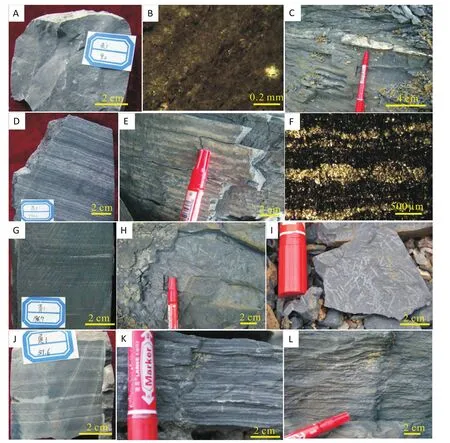
Fig. 3 Core and outcrop photographs showing different kinds of lithofacies. A-Gray clayey shale with massive bedding indicating relatively low energy and rapid deposition. From Well Yuye 1, at a depth of 9 m. B-Low-resolution thin-section photograph showing faint lamination. From Well Yuye 1, at a depth of 13.4 m. C-Black siliceous calcareous shale interbedded with a thin layer of argillaceous limestone. From outcrop of Longmaxi Shale, Jiangkou Town, Wulong County. D-Dark gray siliceous calcareous shale with wavy laminations. Wavy laminations are composed of calcite (10 wt.%) and dolomite (4.3 wt.%). From Well Yuye 1, at a depth of 170.1 m. E-Silty-shaly interlaminated shale comprised of gray siltstone and dark gray shale. From outcrop in Jiangkou Town, Wulong County. F-Thin section of silty-shaly interlaminated shale showing silty layer (bright part) and shale layer (dark part). From outcrops in Lujiao Town, Pengshui County. G-Black siliceous dolomitic shale with horizontal bedding. H-Black graptolite shale with abundant graptolites in the shale interlayer. From outcrop in Lujiao Town, Pengshui County. I-Black graptolite shale developed well in outcrops, Longmaxi Formation, in Hongyanxi Town, Longshan County. J-Gray muddy siltstone characterized by thin light siltstone interbeds and horizontal bedding. From Well Yuye 1, at a depth of 51.6 m. K-Dark gray muddy siltstone with wavy laminations and lenticular bedding indicating a relatively strong hydrodynamic sedimentary environment. Outcrop in Lujiao Town, Pengshui County.L-Gray to yellow muddy siltstone with lenticular bedding and cross-bedding indicating a strong hydrodynamic and oxic sedimentary environment.
4.1.5Muddy siltstone
Muddy siltstone can be subdivided into two sub-lithofacies based on their distribution and sedimentary structures. One type of muddy siltstone is restricted to the upper SLS interval. It is characterized by abundant sedimentary structures, including horizontal bedding, cross bedding,and lenticular bedding (Fig. 3J, 3K, 3L). Low TOC (about 0.9 wt.% in average) and pyrite contents (about 1.2 wt.%in average), and high quartz contents (about 1.2 wt.% in average) are typical for this lithofacies.
The other type of muddy siltstone occur mainly in thick black shale and is interbedded by shale with a gray to dark gray (Fig. 4B, 4C) and black colouration (Fig. 4A) in Well Yuye 1 (located in the northern part of the study area as shown in Fig. 1). The total thickness of this muddy siltstone in this area is ~40 m. A single muddy siltstone layer is usually 5 m to 10 m in thickness, and is often interbedded with black and dark gray shale layers (Fig. 4A).The sedimentary structures include horizontal bedding,deformed bedding, and flame structures (Fig. 4A, 4B, 4C).Mineral content is different from adjacent layers,e.g., its core (Fig. 4C) is composed of quartz with a content of 54.7 wt.%, clay mineral with a content of 24.7 wt.%, feldspar with a content of 19.8 wt.%, and pyrite with a content of 0.8 wt.%. The adjacent layer is comprised of quartz with an average content of 36.4 wt.%, clay mineral with an average content of 53.6 wt.%, feldspar with an average content of 8.5 wt.%, and pyrite with an average content of 1.5 wt.%.

Fig. 4 Core, outcrops and thin section photographs showing sedimentary characteristics of turbidites from the southeastern part of Sichuan Basin. A-Black shale characterized by horizontal bedding, and is probably the E unit of the Bouma sequence. From Well Yuye 1, at a depth of 95.9 m. B-Deformed bedding developed in gray silty shale, showing that the unconsolidated sediments underwent secondary transportation. From Well Yuye 1, at a depth of 98.6 m. C-Deformed bedding developed in gray silty shale, which also shows that the unconsolidated sediments underwent secondary transportation. From Well Yuye 1, at a depth of 81.2 m. D-Thin section showing poorly sorted and poor-rounded characteristics of thin-bedded siltstone embedded in thick layer of dark gray shale as shown in Fig.4F. From SLS outcrops in Hongyanxi Town, Longshan County. E-Flute casts developed widely in thin-bedded siltstone (bottom of the thin layer) as shown in Fig. 4F. From SLS outcrops in Hongyanxi Town, Longshan County. F-Thin-bedded siltstone developed in dark gray shale (the bottom of the bed shown in Fig. 4E). From Longmaxi Formation outcrops in Hongyanxi Town, Longshan County.
The muddy siltstone developed in Longshan County(located in the eastern part of the study area; see Figs. 1 and 7) consists mainly of muddy siltstone and some yellow and dark gray siltstone (Fig. 4E, 4F), and is embedded with in thick layers of dark gray to black shale (Fig. 4F).A single sheet layer is usually less than 10 cm in thickness in the middle and lower parts of this section, and is thicker in the upper part of the section (up to 1 m). Sedimentary structures of this lithofacies include flute casts(Fig. 4E) and massive bedding. Mineral content is also different from the adjacent layer,e.g., an outcrop sample(Fig. 4E) is composed of quartz with a content of 81 wt.%,clay mineral with a content of 12 wt.%, and feldspar with a content of 7 wt.%, whereas the adjacent layer comprises quartz with an average content of 43.4 wt.%, clay mineral with an average content of 46.6 wt.%, feldspar with an average content of 9 wt.%, and pyrite with an average content of 1 wt.%.
4.1.6Graptolite shale
This lithofacies is common in the SLS, especially in the lowermost part of the core, deeper than 100 m (Fig. 5), as well as in outcrop, and is characterized by the high abundance of graptolites (Fig. 3H, 3I). Graptolites from the SLS in the study area chiefly belong to monograptids, with only few belonging to the diplograptids. Graptolite shale is also characterized by black colour, horizontal bedding,and high content of TOC (about 2.6 wt.% on average) and pyrite (about 4 wt.% on average). Quartz is the dominant mineral with an average content of 42 wt.%. Less abundant minerals include clay mineral with an average content of 39 wt.% and carbonate with an average content of 5 wt.%(Table 1). U content is relatively higher compared with other lithofacies. K and Th contents are lower than those from other intervals of the SLS (Fig. 5).
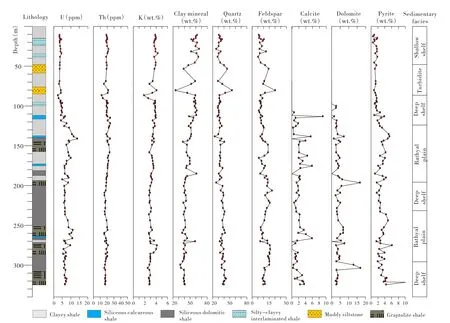
Fig. 5 Lithologic and sedimentary facies with corresponding elemental and mineral data for Well Yuye 1.
4.2 Sedimentary facies association and distribu‑tion
Three sedimentary facies associations,i.e., inner shelf,outer shelf, and bathyal plain (including turbidites), are recognized in the SLS in study area.
4.2.1Sedimentary facies association in Well Yuye 1
In the lower intervals of the SLS of Well Yuye 1, U and pyrite contents, which can be indexed to the presence of reducing conditions, are both high, implying strongly reducing conditions during deposition (Fig. 5). In this interval, outer shelf and bathyal plain palaeoenvironments are dominant. Siliceous dolomite shale was mainly deposited in outer shelf environments, while graptolite shale was mainly developed in bathyal plain environments. Generally, clayey shale accumulated over a larger area, including inner shelf, outer shelf, and even bathyal plain. One type of muddy siltstone (turbidite) was deposited on the bathyal plain, and the other was deposited on the inner shelf. Siltyclayey interlaminated shale and siliceous calcareous shale was generally deposited in an inner shelf sedimentary environment.
4.2.2Correlation among outcrops and well core
The studied outcrops and Well Yuye 1 are correlated with gamma-ray patterns and/or facies architecture in the study area (Fig. 6). The SLS thins toward the south, that is, in southern direction the bathyal plain and outer shelf sedimentary facies terminates, whereas the inner shelf sedimentary facies thickens. Turbidites are restricted to only the northern part of the study area. This is especially clear in the Well Yuye 1 area, where bathyal plain deposits(including turbidites) are thickest and form the depocenter.The depth of the SLS stratum in the Well Yuye 1 area is greatest, and it remains the same as the depocenter.
4.2.3Distribution of sedimentary facies
The dominant facies in the lower part of the SLS are outer shelf and bathyal plain (Fig. 7A). These two facies were deposited in the middle and northern parts of the study area. The inner shelf, including sandy shelf and muddy shelf, was restricted and only located in the southern and northeastern parts of the study area. Generally,the facies are distributed symmetrically and water depth reached its maximum in the middle of the study area, decreasing towards the northeast and south.
Along with the fall of the sea level and the water shallowing, the predominant facies in the upper part of the SLS (Fig. 8B) were inner shelf, including sandy shelf and muddy shelf. Compared with the lower part of the SLS,the distribution of the two facies expands to the north and is mostly deposited in the southern part of the study area.Meanwhile, the distribution of outer shelf and bathyal plain facies decreased and was only developed in the northern part of the study area. With the drop of the sea level, sediment supply was comparatively abundant, resulting in the development of turbidites in bathyal plain environment.Cores of Well Yuye 1 and outcrops of Hongyanxi Town,Longshan County both show the development of turbidites, with slump deformed bedding and flute casts (Fig. 4E,4F). The formation and preservation of turbidites in the study area may therefore indicate a relatively deep water depositional environment.
5 Discussion
5.1 Sedimentary environment of each type of shale
Shales with gray colour and horizontal bedding normally formed in a weakly reducing condition with active hydrodynamics (Galloway and Hobday, 1996; Jiang, 2010).Abouelresh and Slatt (2012) suggest that the proportions of K, U, and Th provide insight into provenance, deposition,and diagenesis of the shale. The K- and Th-rich muddy deposits indicate more rapid sedimentation and inheritance of minerals with terrestrial affinity (Paxtonet al., 2007). U generally accumulates in phosphates, organic matter, and U-bearing minerals that are deposited on a muddy substrate under conditions of anoxia and slow sedimentation(Abouelresh and Slatt, 2012). The relatively lower content of U in the clayey shale indicates that it was deposited under relatively reducing conditions and slow sedimentation.But higher contents of K and Th suggest that the clayey shale was formed relatively rapidly and with an influx of terrestrial material. These characteristics coupled with the relatively low TOC (1.1 wt.%) indicate a low-energy,weakly reducing and relatively rapid depositional environment. Probably, they were mostly deposited on the inner shelf, and some were deposited on the outer shelf.
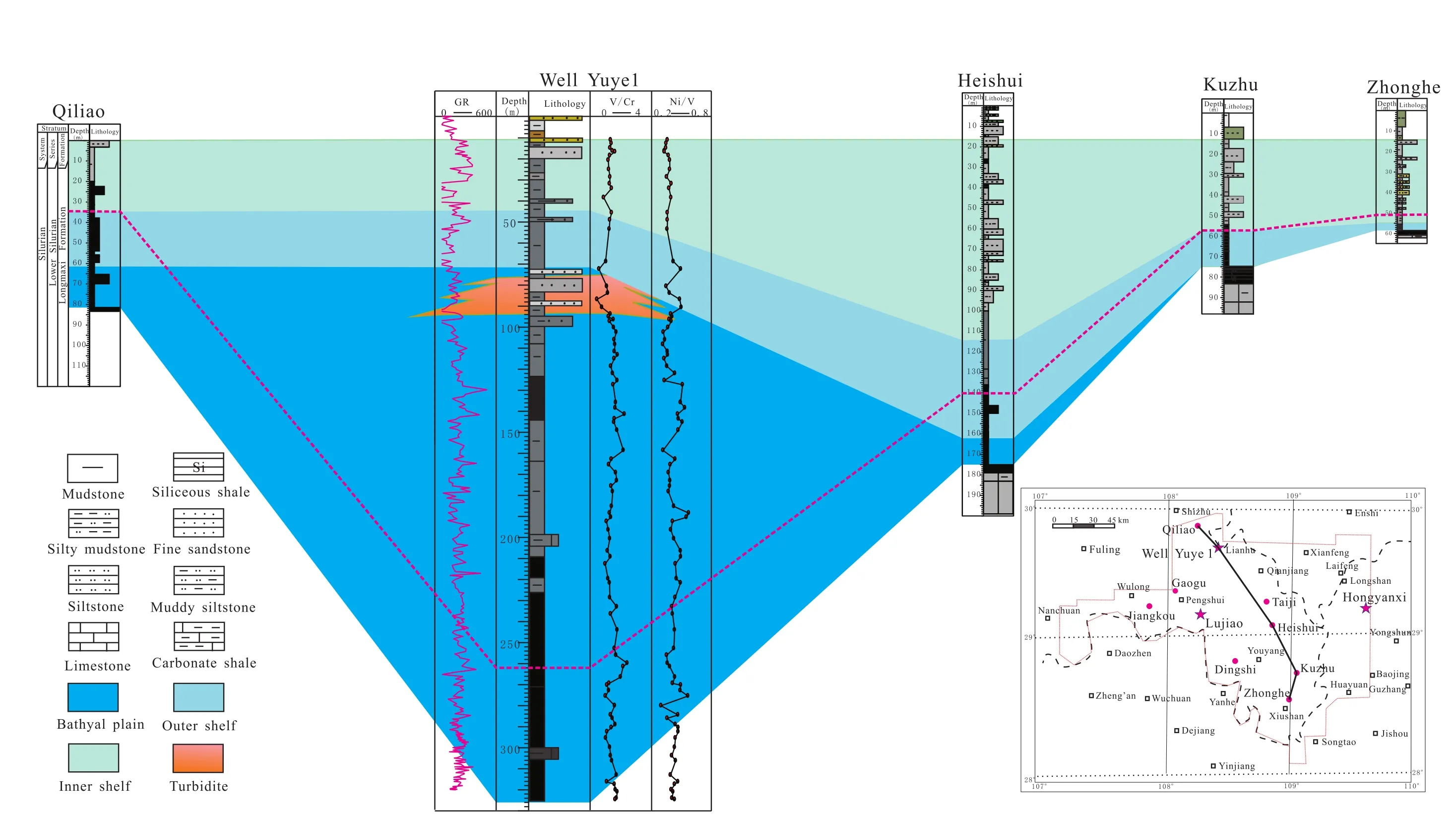
Fig. 6 Cross-section through the study area to correlate the identified sedimentaryfacies with gamma-ray andfield outcrops; the cross-section passes through Qiliao profile, Well Yuye 1,Heishui profile, Kuzhu profile and Zhonghe profile from the northwest to the southeast part of the study area.
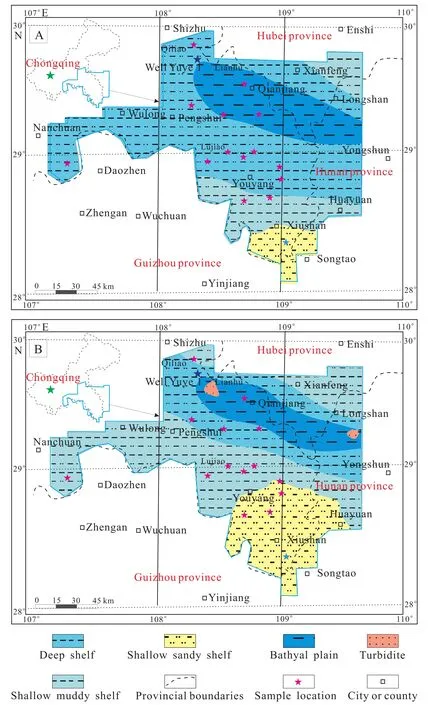
Fig. 7 Sedimentary facies map of the Lower SLS (A) and the Upper SLS (B) in the southeastern Sichuan Basin.

Fig. 8 Relationships of the absorbed gas content and TOC (A) and of the pore volume and TOC (B).
U content in the siliceous calcareous shale is higher than that in the clayey shale, indicating a stronger reducing depositional environment compared with that of the clayey shale. The content of Th and K is a little higher than that in the clayey shale, illustrating a more rapid deposition. The above-mentioned characteristics and higher TOC in this facies are attributed to the relatively deep water and anoxic setting. The higher content of U and the lower content of K and Th, together with the high content of TOC (~2.3 wt.%)in the siliceous dolomitic shale imply that this kind of rock formed slowly in relatively deep, reducing water. Based on sedimentary structures, such as wavy laminations (Fig.3D) and horizontal bedding (Fig. 3G), coupled with the relatively dark colour, these two kinds of shale,i.e., the siliceous calcareous shale and the siliceous dolomitic shale,were mostly deposited in an outer shelf environment and at least partially in a bathyal plain environment.
The repetitive alternations of gray and black laminae and the occasional wavy laminations and horizontal bedding in the silty-clayey interlaminated shale indicate alternating energy levels of depositional events (Singhet al.,2008). These characteristics indicate that this kind of rock was deposited in shallow water that might be linked to an inner shelf environment.
Jiang (2010) suggested that lenticular bedding developed under the control of tides or waves where sandy deposits were in short supply, resulting in the preservation of more muddy deposits than sandy deposits. Cross bedding and lenticular bedding indicate that the depositional setting is shallow and the hydrodynamic condition is stronger. Th and K contents are relatively high, indicating that this lithofacies was deposited rapidly comparing with other lithofacies. These characteristics allowed us to determine that this kind of muddy siltstone was deposited on the inner shelf. Flute casts developed in muddy siltstone and the abrupt changes of mineral content from adjacent layers suggest that they are episodic deposits. Based on sedimentary structures and mineral composition changes,they can likely be attributed to turbidites, which are commonly deposited in the bathyal plain environment as de-scribed by Jiang (2010).
The dominance of black-coloured, well-laminated shale without bioturbation suggests that this lithofacies formed in a persistent stratified and anoxic water column (Jianget al., 2011). Pyrite in the black shale also suggests that it was formed in anoxic water. Black shale containing abundant graptolites generally formed in a confined or semiconfined deep and calm sea basin as suggested by Sun and Liu (2006). Under such conditions, because of strongly reducing water with no or little oxygen in the bottom of the water column, only planktonic organisms, such as graptolites, could survive (Sun and Liu, 2006); as a result, the black shale with abundant graptolites formed. This lithofacies was most likely deposited in a low-energy, strongly reducing, and relatively slowly-depositing environment of the bathyal plain.
5.2 Shale gas significance
Source rocks formed in different environments exhibit different hydrocarbon generation potentials (Sun and Puttmann, 2004; Sun and Liu, 2009). Source rock with a high content of TOC, such as black shale, is suitable for shale gas accumulation as suggested by earlier studies from Curtis (2002) and Nieet al. (2009). TOC is one of the key factors for shale gas accumulation, and it has certain effects on the physicochemical properties of black shale,including density, and resistance to weathering. TOC partially controls fracture development in black shale and also greatly influences the shale gas content as suggested by Zhanget al. (2008). Higher concentrations of organic carbon commonly exhibit the higher gas in place, the highest matrix porosity, and the lowest clay content (Bowker,2007). The adsorbed shale gas contained in the shale is greatly affected by TOC, and they have an approximately positive correlation (Fig. 8A). Moreover, there is a strong relationship between micro-pore volume and TOC (Fig.8B), suggesting that organic pores are existent and dominant in shale. Siliceous dolomitic shale, siliceous carbonate shale, and graptolite shale developed in the northern part of the study area, including the depositional center,are attractive for shale gas exploration and exploitation because of their high content of TOC.

Fig. 9 Ternary plot of the mineral composition of the Longmaxi Shale in Well Yuye 1.
Black shale serves as a shale gas reservoir, and its development in different environments contributes to its varied mineral composition, which greatly impacts the character of the shale gas reservoir. The formation of shale gas reservoirs requires not only a higher abundance of organic matter, but also a certain amount of quartz, feldspar, carbonate, and other brittle minerals as suggested by Wanget al. (2009). The mineral composition of the SLS (Fig.9) suggests that quartz, feldspar, and clay minerals are dominant, and the total quartz and feldspar content ranges primarily between 40 wt.% and 60 wt.%, except for a few negative excursions. The content of clay minerals is approximately similar to the total quartz, feldspar and pyrite content. The carbonate content is less than 14 wt.%. The mineral distribution and brittle features are quite similar to the Ohio Shale and the Barnett Shale, which are both important commercial gas producting shales in the USA(Bowker, 2007; Jarvieet al. 2007).
Mineral composition is a controlling factor for rock fragility, and when brittle minerals, such as quartz and carbonate, are more abundant, the brittleness of shale will be the greater (Curtis, 2002; Jarvieet al., 2007). Jarvieet al.(2007) also suggests that mineralogy analysis is absolutely necessary in studying a shale gas reservoir, especially in a fracturing-requiring reservoir, such as the Barnett Shale. Even though the black shale has good attributes for production, accumulation and storage, fractures remain essential because gas migration would otherwise be limited to a great degree by poor reservoir connectivity. As discussed above, siliceous dolomitic shale, siliceous calcareous shale, and graptolite shale contain high contents of brittle minerals, such as quartz, carbonate and pyrite(Table 1), and, hence, from this perspective (together with the TOC content), these types of black shales are suitable for shale gas exploration and exploitation in the study area.
6 Conclusions
1) Six lithofacies in the SLS have been recognized in the southeastern Sichuan Basin, namely (1) clayey shale,(2) siliceous calcareous shale, (3) siliceous dolomitic shale, (4) silty-clayey interlaminated shale, (5) muddy siltstone, and (6) graptolite shale.
2) Siliceous dolomitic shale, siliceous carbonate shale,and graptolite shale contain higher amounts of U and TOC,and lower amounts of K and Th. These characteristics indicate that they were deposited slowly in relatively deep,reducing water.
3) Three distinguished sedimentary facies,i.e., inner shelf, outer shelf, and bathyal plain developed in Longmaxi Formation in the study area.
4) Siliceous carbonate shale, siliceous dolomitic shale,and graptolitic shale are rich in TOC, which is suitable for the generation and adsorption of abundant gas. The presence of brittle minerals, such as quartz, feldspar, carbonate and pyrite in these shales is beneficial for the formation of natural fractures. Therefore, these shales are the optimum target plays for shale gas exploration and exploitation, especially those developed in the northern part of the study area.
Acknowledgements
This research was supported by the National Key Science and Technology Projects of China (No. 2011ZX05009-002), the National Natural Science Foundation of China(No. 40672078), and the Yangtze River Scholar and Innovative Team Development Plan of the Ministry of Education of China (No. IRT0864). Thanks for the help in field work from Professor Zhang Jinchuan and Ding Wenlong of China University of Geosciences (Beijing).
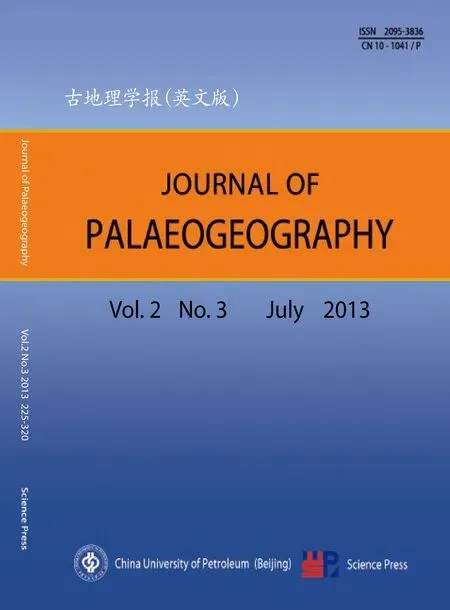 Journal of Palaeogeography2013年3期
Journal of Palaeogeography2013年3期
- Journal of Palaeogeography的其它文章
- Palaeogeographical zonation of gypsum facies:Middle Miocene Badenian of Central Paratethys(Carpathian Foredeep in Europe)
- Lithofacies palaeogeography and biostratigraphy of the lowermost horizons of the Middle Triassic Hallstatt Limestones (Argolis Peninsula, Greece)
- Environment controls on Mesoproterozoic thrombolite morphogenesis: A case study from the North China Platform
- Artemisia pollen-indicated steppe distribution in southern China during the Last Glacial Maximum
- Palinspastic reconstruction and geological evolution of Jurassic basins in Mongolia and neighboring China
- 1st International Palaeogeography Conference September 14–17, 2013 Beijing, China
